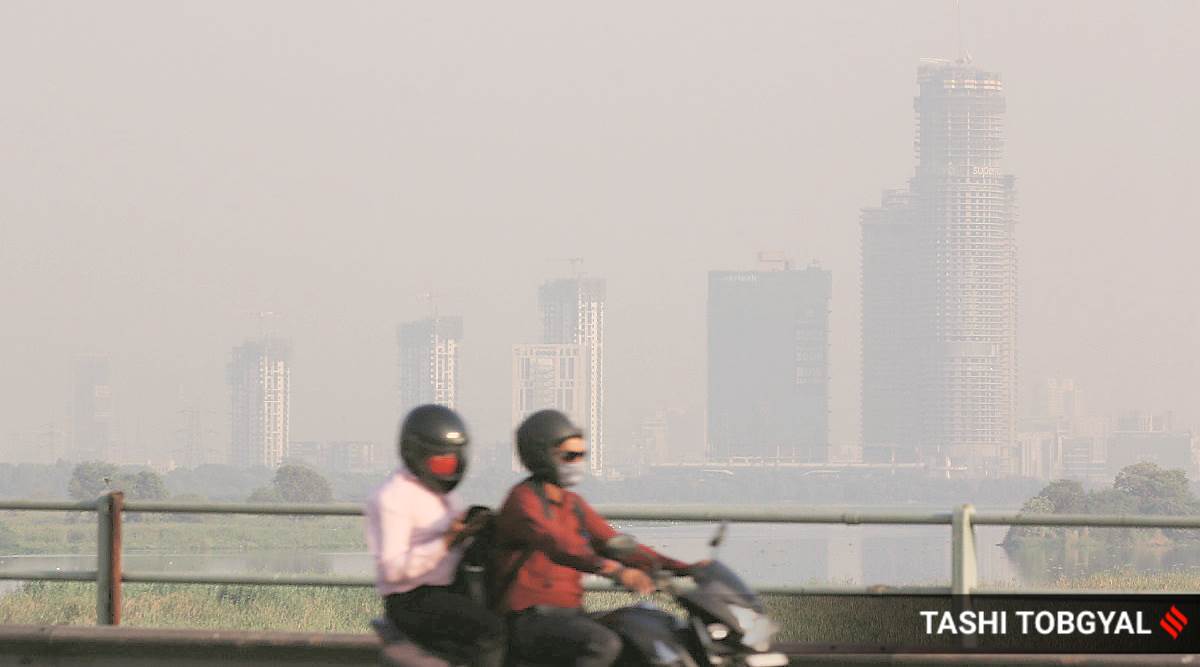 High PM2.5 levels are seen during winter and post-monsoon.
High PM2.5 levels are seen during winter and post-monsoon.Ultrafine particles suspended in the air constitute more than 50% of the total particulate matter of 2.5 micrometres (PM2.5) size around the year in Delhi, and are associated with higher cytotoxicity in human lung cells, a new study from the Indian Institute of Technology (IIT) Delhi shows.
Data from the study sheds light on the necessity of routine monitoring of ultrafine particles that are below PM2.5 micrometres in size, and particularly PM size lower than 0.25, which is linked with more cytotoxicity — the quality of being toxic to the body’s cells.
The study, published in Elsevier’s peer-reviewed journal Environmental Pollution in September, also found that PM2.5 levels have no relation to PM<0.25 levels. “In other words, a decrease in total PM2.5 levels may not be associated with a decrease in PM<0.25 levels… These findings unequivocally suggest that total PM2.5 levels are not good indicators of PM<0.25 levels,” the paper states.
Authored by experts from IIT Delhi’s Civil Engineering and Biological Sciences department, the study is titled ‘Insights on the biological role of ultrafine particles of size PM<0.25: a prospective study from New Delhi’.
While the adverse impact on health from chronic exposure to PM2.5 is well established — including stroke, lung cancer, and other heart and lung related problems — different size fractions within PM2.5 have not been well studied, the study states.
It adds that the National Ambient Air Quality Standard has fixed a threshold for PM2.5 at 60 µg/m3 for 24 hours and 40 µg/m3 annually, but it does not have specific policies for ultrafine particles.
High levels of PM2.5 are recorded in Delhi every year during post-monsoon and winter months, which in the past have led authorities to declare a public health emergency on some days and close schools.
“Considering that PM2.5 levels in some developing countries, such as India, reach to over 15-fold higher than the recommended limit, the absolute concentration of different sizes of particles within PM2.5 may be very high and is worthy of further investigation,” the IIT study states.
Data for the study was collected six times every month between January and December 2017, through a cascade impactor measurement device installed at the main gate of IIT Delhi, at the height of human breathing zone — 1 to 1.5 metre.
Airborne particles in five sizes — 2.5, 1, 0.5, 0.25 and below 0.25 micrometres — were collected through the filters. Human lung carcinoma epithelial cells were used for cytotoxicity assessment.
“For PM particles of size up to 2.5 µm, 1.0 µm, 0.5 µm and <0.25µm, the cumulative average mass concentration values were found to be highest for the post-monsoon season (October-December), followed by winter (January-February),” the study said.
“The observed high levels of PM in the post-monsoon and winter months may be partially explained by celebration of Diwali, agricultural residue burning in neighbouring states of Punjab and Haryana, and secondary formation of particles due to favourable meteorological conditions. The low temperature and high humidity during winter nights enhance the fog-smog-fog cycle and result in 2-3-fold increase in PM concentration compared to pre-monsoon and South-West monsoon season,” the study said.
Findings also show particulate matter of below 0.25 micrometres constituted the highest share in the composition of PM2.5 around the year as compared to particles of other sizes.
The PM<0.25 particles constituted over 40% of PM2.5 levels during post-monsoon season, and over 30% during winters and pre-monsoon period between March and May.
Their concentration was highest during the monsoon between June and September, constituting over 50% of PM2.5 levels. Further investigation is needed to find the reason behind the spike in particles of this size during these months, the study states.
Exposure to ultrafine particles of below 0.25 micrometres was also associated with over two-fold higher cytotoxicity, as compared to exposure to other sizes.
“The highest toxicity was seen for the months of January 2017 and February 2017,” the study said.
It concludes by stating that findings demonstrate a potentially important link between PM<0.25 levels and human health. “We believe this work provides novel insights for policy changes in monitoring PM, especially the need to routinely monitor PM<0.25 and the necessity to start working towards establishing exposure limits for PM<0.25 when the total PM2.5 levels are breached,” the study concludes.
📣 The Indian Express is now on Telegram. Click here to join our channel (@indianexpress) and stay updated with the latest headlines
For all the latest Delhi News, download Indian Express App.